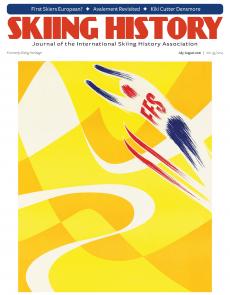SKIING HISTORY
Editor Seth Masia
Managing Editor Greg Ditrinco
Consulting Editor Cindy Hirschfeld
Art Director Edna Baker
Editorial Board
Seth Masia, Chairman
John Allen, Andy Bigford, John Caldwell, Jeremy Davis, Kirby Gilbert, Paul Hooge, Jeff Leich, Ron LeMaster, Bob Soden, Ingrid Wicken
Founding Editors
Morten Lund, Glenn Parkinson
To preserve skiing history and to increase awareness of the sport’s heritage
ISHA Founder
Mason Beekley, 1927–2001
ISHA Board of Directors
Rick Moulton, Chairman
Seth Masia, President
Wini Jones, Vice President
Jeff Blumenfeld, Vice President
John McMurtry, Vice President
Bob Soden (Canada), Treasurer
Einar Sunde, Secretary
Richard Allen, Skip Beitzel, Michael Calderone, Dick Cutler, Ken Hugessen (Canada), David Ingemie, Joe Jay Jalbert, Henri Rivers, Charles Sanders, Christof Thöny (Austria), Ivan Wagner (Switzerland)
Presidential Circle
Christin Cooper, Billy Kidd, Jean-Claude Killy, Bode Miller, Doug Pfeiffer, Penny Pitou, Nancy Greene Raine
Membership Services
Laurie Glover
(802) 375-1105
laurie@skiinghistory.org
Corporate Sponsorships
Peter Kirkpatrick
(541) 944-3095
peterk10950@gmail.com
Bimonthly journal and official publication of the International Skiing History Association (ISHA)
Partners: U.S. Ski and Snowboard Hall of Fame | Canadian Ski Museum and Hall of Fame
Alf Engen Ski Museum | North American Snowsports Journalists Association | Swiss Academic Ski Club
Skiing History (USPS No. 16-201, ISSN: 23293659) is published bimonthly by the International Skiing History Association, P.O. Box 1064, Manchester Center, VT 05255.
Periodicals postage paid at Manchester Center, VT and at additional mailing offices. Postmaster: Send address changes to ISHA, P.O. Box 1064, Manchester Center, VT 05255
ISHA is a 501(c)(3) public charity. EIN: 06-1347398
Written permission from the editor is required to reproduce, in any manner, the contents of Skiing History, either in full or in part.
Seven Decades at Belleayre
Resorts: From CCC-cut trails to a new gondola, the state-owned ski area has become a public-works success story.
Photo above: Opening day in January 1950, launched the first chairlift in New York State. The Roebling single was built by the New Jersey company that built the Brooklyn Bridge. Belleayre Mountain photo.
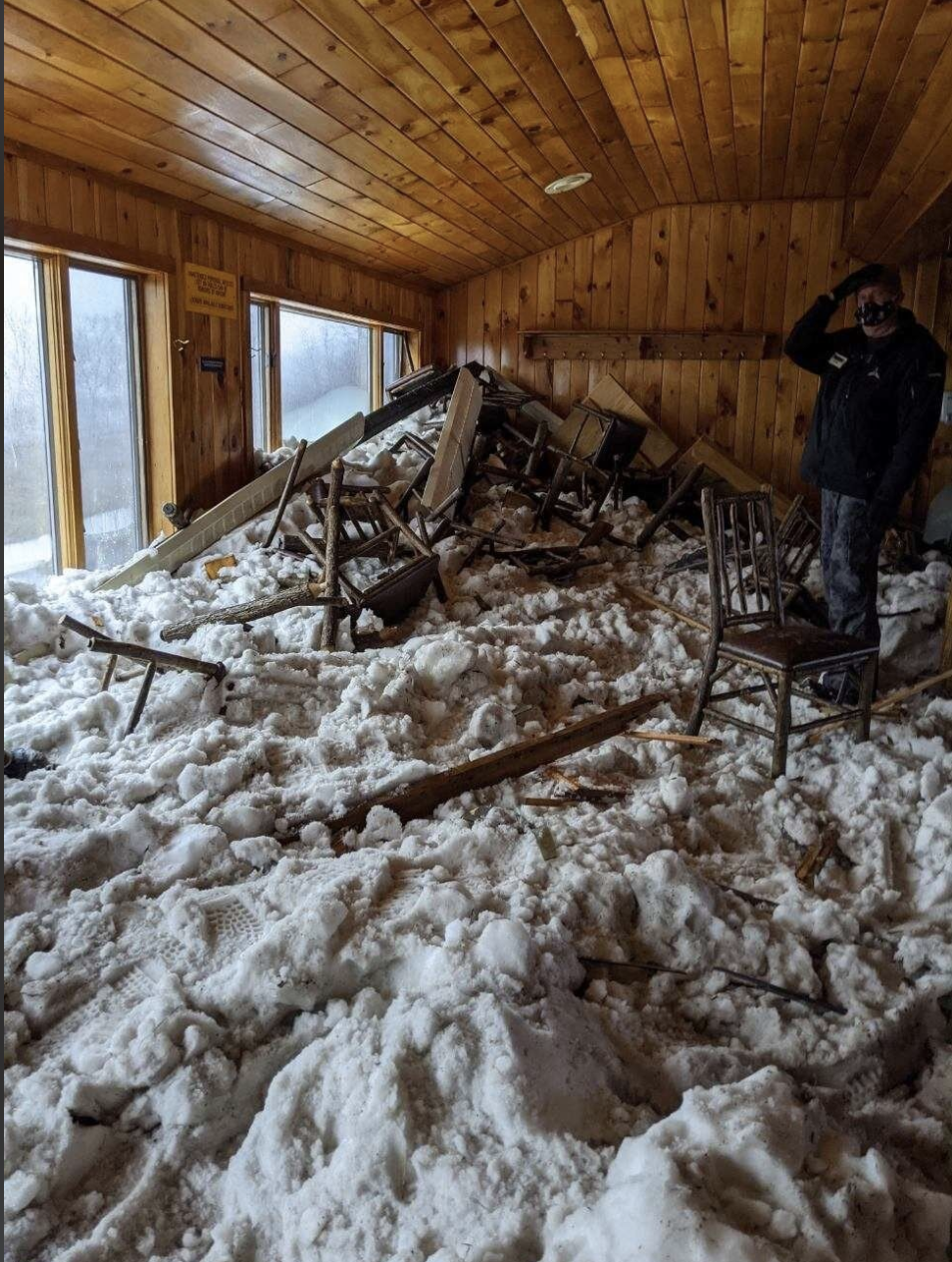
wet-snow avalanche to the
Overlook Lodge.
On Christmas Eve 2020, as Belleayre Ski Area was settling into operation under Covid-19 restrictions, six inches of rain fell overnight. Christmas dawn revealed that a wet-snow avalanche had cascaded through the windows and across the floor of the upper-mountain Overlook Lodge. The resort closed for two days. The lower base lodge was not affected.
It hasn’t always been easy going for Belleayre, the Catskills ski area owned and operated by New York State. But over the past four years, the state has come through with $25 million to build a bottom-to-top gondola and a new quad lift, plus other upgrades. After 70 years, the resort’s viability seems assured.
Just a two-hour drive north of the George Washington Bridge, and in the heart of the Catskills resort region, Belleayre has always had the advantage of location. Partly because of the state’s involvement, in 1950 it became the first chairlift-served ski area in New York. But as a public entity, Belleayre has had a complex legal history.
Partly to assure clean water for New York City, the state instituted a “Forever Wild” article in the state constitution in 1895. That was amended by referendum in November 1941 to allow construction of a ski area on Marble Mountain near Lake Placid (see Skiing History, May-June 2015). World War II halted work on that ambitious project.
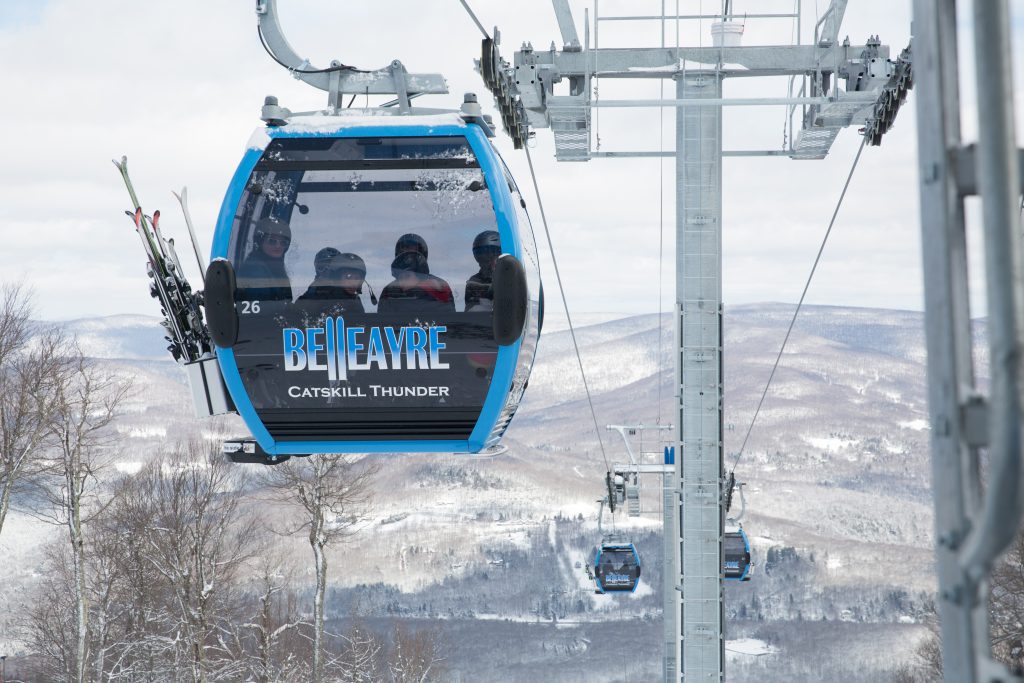
2017, brought Belleayre into the
21st century.
Maltby Shipp of nearby Newburgh, with his son, gained local fame in 1929 as the first to hike up and ski down Belleayre’s 2,000 vertical feet, and the Civilian Conservation Corp cleared a trail—one of seven Catskill ski trails cut during the Depression years.
Returning WWII veterans led the resurgence of interest in skiing, and beginning in 1945, the Central Catskills Association, a group of local business and civic leaders, pushed for the development of a state-owned ski area that would add winter recreation to this already popular summer tourist destination. In 1947, the state passed legislation to allow additional ski area development at Belleayre and at North Creek.
Skiing was just an extension of what New York was already doing, according to Lowell Thomas, then the spokesman for the state’s Chamber of Commerce: “Both ski centers should offer in winter the same sort of inexpensive recreation as Jones Beach offers in the summer,” he said.
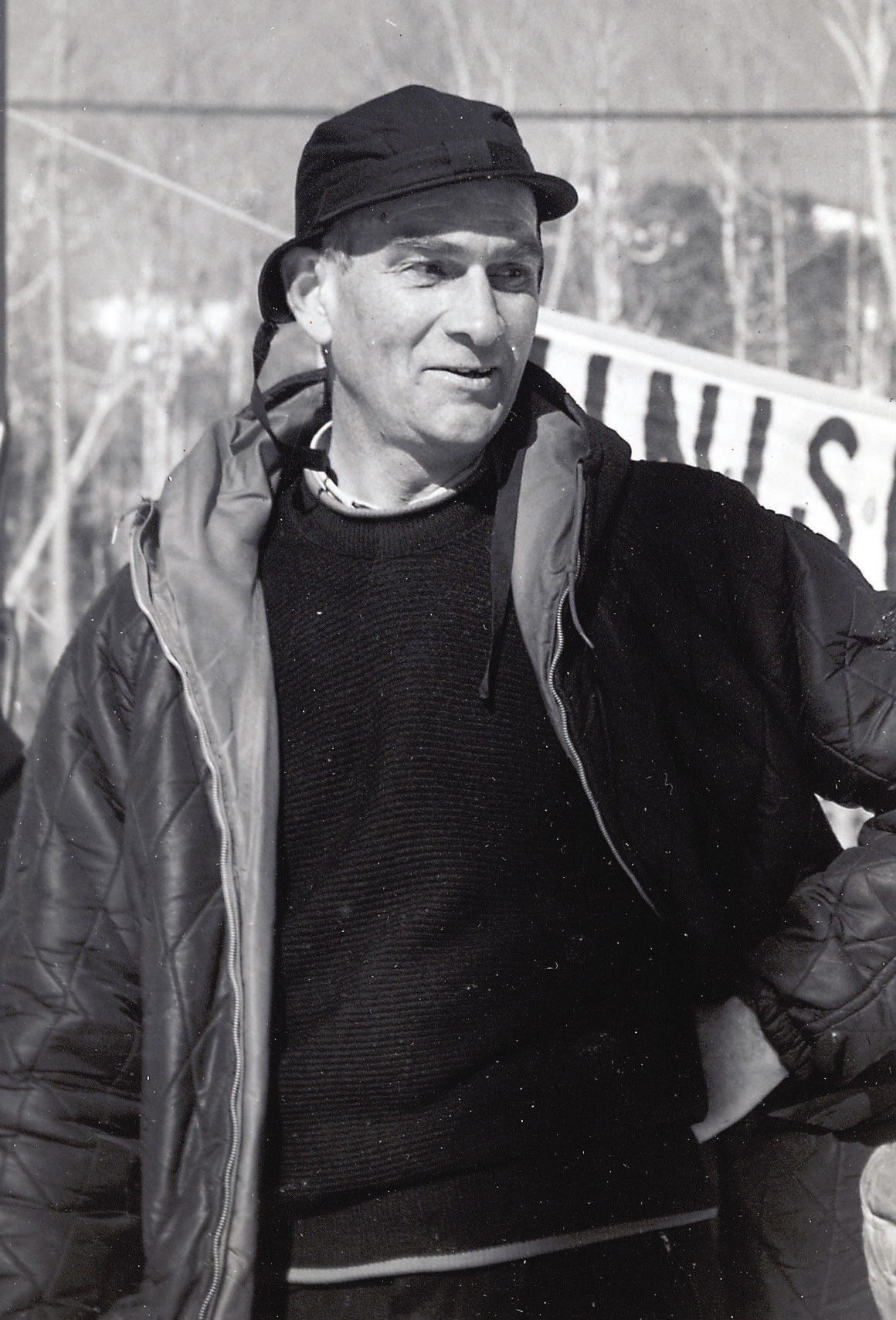
veteran, drove Belleayre’s
construction in 1949.
The construction of the ski area started in 1949 under the supervision of Art Draper. A Harvard graduate and New York Times reporter, Draper fled the city in 1938 to become a forest ranger. He helped to launch the Marble Mountain project, then, at the relatively advanced age of 32, he volunteered for the 10th Mountain Division and saw heavy combat as a medic. He would serve as Belleayre’s first superintendent, the state’s quaint term for what anyone else would call a general manager.
The state allocated the manpower and $250,000 to build three main trails, a summit lodge, a temporary base lodge, a cafeteria, a workshop, a mile of access road and a 400-car parking lot.
Draper brought in Otto Schniebs, the one-time Dartmouth ski coach, who by then was living in Lake Placid and coaching the St. Lawrence University ski team. In the 1930s he had been involved in the layout of the Thunderbird race trail on Mt. Greylock in the Berkshires and then in planning for Marble Mountain. He would advise on Belleayre’s trails and lifts layout.
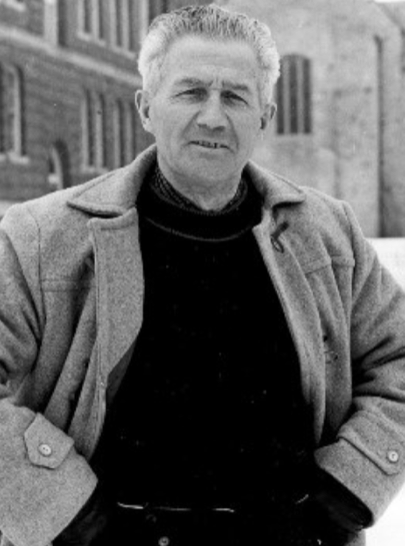
Dartmouth coach,
advised on lift and trail
layouts.
Draper also brought to Belleayre Dot Hoyt Nebel, whom he knew from North Creek, where she had been the director of the Ski Bowl Ski School (Ski Bowl got a rope tow in 1935, to serve ski-train tourists). A math teacher turned ski racer, Nebel had been selected to the U.S. Alpine team for the cancelled 1940 Winter Olympics and during the war taught skiing at Pico Peak, where she was Andrea Mead’s first race coach. She was not impressed with the trail layout proposed for Belleayre. Nebel believed the ski trails should follow the fall line. And she knew how to make that happen. “You just go to the top of the mountain and drop a ball,” she said years later. “You see where it goes and that is where you make the trail.” She would remain at Belleayre for 17 years as head of the ski school. The Dot Nebel is a black-diamond run at the mountain today.
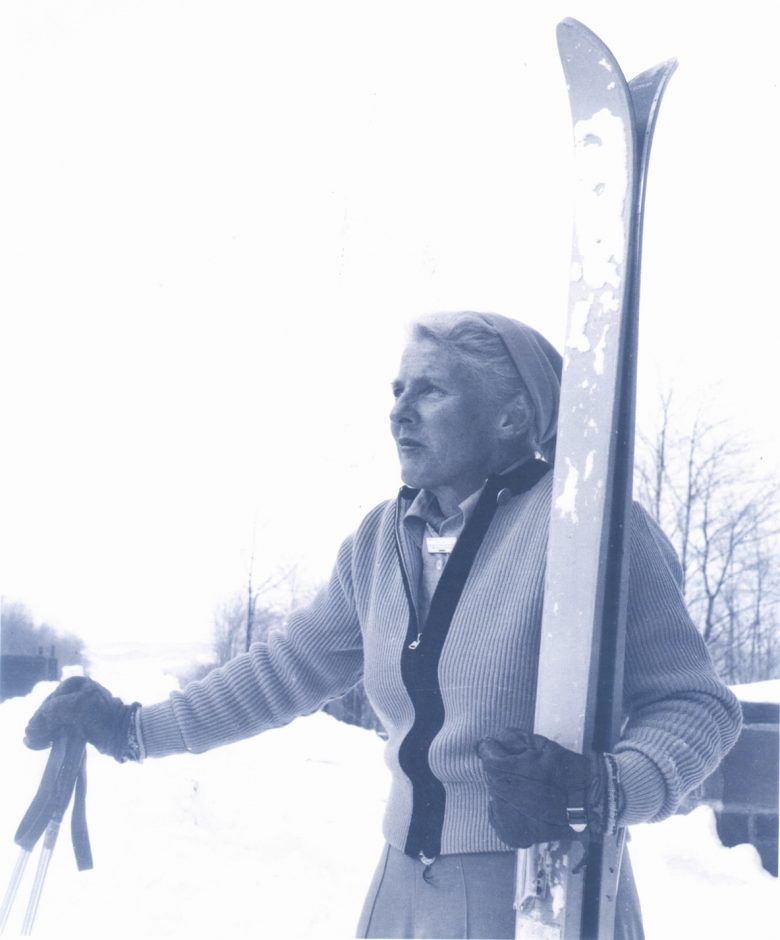
trail layout and founded
the ski school.
At the opening on January 22, 1950, Belleayre featured an electric rope tow and a 3,000-foot long Roebling single chair, the first chairlift in New York State. There wasn’t enough snow to ski that day but several hundred sightseers rode the lift for free. Enough snow arrived in February for Belleayre to co-host the New York State Alpine Combined Championships (the other co-host was Highmount, a rope-tow area on the north side of Belleayre, founded in 1947). The cost of the Belleayre lift ticket that winter was $3.50.
Belleayre grew in the next decades and its separate lower mountain beginner terrain was especially popular. In the meantime, the Marble Mountain ski area had proven a wind-scoured bust. With Draper in the lead, supported by Gov. Averell Harriman, the state opened nearby Whiteface in 1956. Gore Mountain opened in 1964.
At the time, the three ski areas were managed by New York’s Department of Conservation. The state’s budget year ended on March 31, and that meant each of the areas closed on that date, no matter what the snow conditions at the time.
In 1974, after years of trying, Lake Placid was awarded the 1980 Winter Olympics. Leading up to the games, the state ponied up millions of dollars for facilities upgrades. There wasn’t much money for the other two state areas.
Then the games were over.
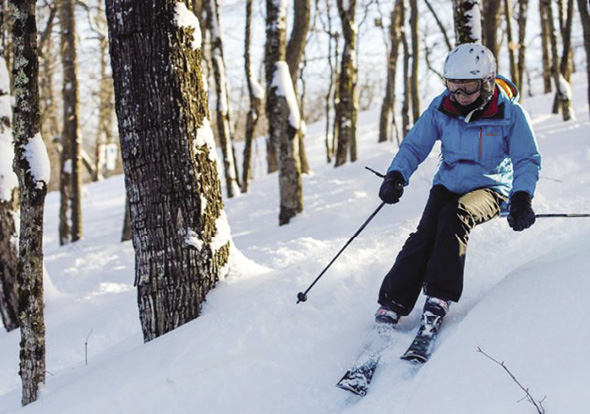
double-diamond. Beware of hardwood.
New York State officials had paid attention to the aftermath of the 1960 Olympics. Twenty years later little evidence remained at Squaw Valley that the event had ever occurred. To assure that its investment would be preserved and utilized, in 1981 New York’s legislature created the Olympic Regional Development Authority (ORDA) to manage and market the Lake Placid facilities. The first CEO was Ned Harkness, a prominent hockey coach and facilities executive, who served until 1993.
While the Olympic facilities got the attention, Belleayre and Gore were initially left out of ORDA. Facilities had aged and snowmaking, the lifeblood of Eastern skiing, was minimal. Gore was folded into ORDA in 1984, but at the same time the state comptroller recommended closure of Belleayre. Governor Mario Cuomo budgeted only $100,000 for the area, just enough to shut it down.
A grassroots organization, the Coalition to Save Belleayre, quickly sprang up, headed by Joe Kelly, a New York City securities industry executive and long-time Catskills second-home owner. Thirteen thousand people signed a petition to save the ski area.
The New York Times and the New York Post were the two most prominent newspapers to run editorials supporting Belleayre. The economic impact of the ski area on the regional economy was a major argument. It worked. Before the end of 1984, the decision to close Belleayre was reversed. Over the next eight years, the state allocated $6 million to upgrade machinery and equipment at the area. In 1987, voters approved another constitutional amendment allowing expansion of the ski terrain and improvements to the trail layout.
Finally, in 2012, ORDA took over Belleayre, under a blended board of directors that includes representation from all three state-owned ski areas. It seems to be a good arrangement. Belleayre now has expanded snowmaking to cover 96 percent of the terrain, which includes 50 trails spread over 175 acres, plus increased base lodge capacity. With the Catskill Thunder gondola installed in 2017 and a new detachable quad lift in 2020, the future of the area seems solid. Avalanches notwithstanding. 
Phil Johnson is a ski columnist for the Syracuse Daily Gazette. His last Skiing History article was a visit with Hunter Mountain’s Karl Plattner (May-June 2017).
Table of Contents

Corporate Sponsors
ISHA deeply appreciates your generous support!
WORLD CHAMPIONSHIP ($3,000 AND UP)
Gorsuch
Polartec
Warren and Laurie Miller
CHAMPIONSHIP ($2,000)
Fairbank Group: Bromley, Cranmore, Jiminy Peak
Hickory & Tweed Ski Shop
Rossignol
Snowsports Merchandising Corp.
WORLD CUP ($1,000)
Aspen Skiing Company
Berkshire East Mountain Resort/Catamount Mountain Resort
Bogner
Boyne Resorts
Dale of Norway
Darn Tough Vermont
Dynastar | Lange | Look
Gordini USA Inc. | Kombi LTD
HEAD Wintersports
Intuition Sports, Inc.
Mammoth Mountain
Marker-Volkl USA
National Ski Areas Association
Outdoor Retailer
Ski Area Management
Ski Country Sports
Sport Obermeyer
Sports Specialists, Ltd.
Sun Valley Resort
Vintage Ski World
World Cup Supply
GOLD ($700)
Larson's Ski & Sport
Race Place | BEAST Tuning Tools
The Ski Company (Rochester, NY)
Thule
SILVER ($500)
Alta Ski Area
Boden Architecture PLLC
Dalbello Sports
Deer Valley
Ecosign Mountain Resort Planners
Fera International
Holiday Valley
Hotronic USA, Inc. | Wintersteiger
MasterFit Enterprises
McWhorter Driscoll, LLC
Metropolitan New York Ski Council
Mt. Bachelor
New Jersey Ski & Snowboard Council
Russell Mace Vacation Homes
Schoeller Textile USA
Scott Sports
Seirus Innovations
SeniorsSkiing.com
Ski Utah
Steamboar Ski & Resort Corporation
Swiss Academic Ski Club
Tecnica Group USA
Timberline
Trapp Family Lodge
Western Winter Sports Reps Association
World Pro Ski Tour
Yellowstone Club


